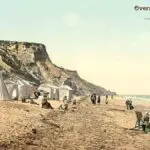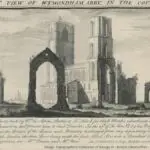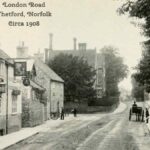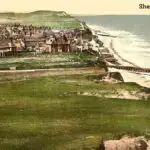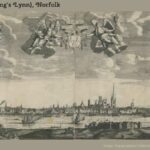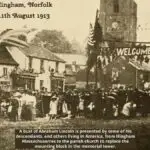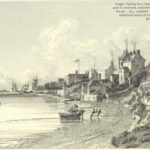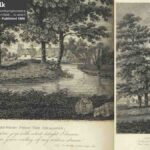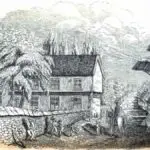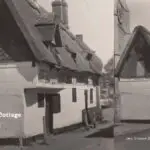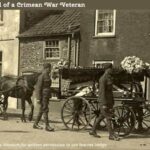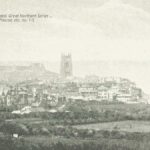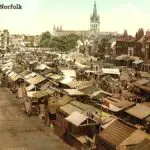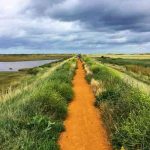Glimpse history through old images of Fakenham, Norfolk, England.
Tennis (1939)
World War II was just weeks away, but local chefs enjoyed a comedy game of tennis using frying pans, watched by a sizeable crowd of spectators.
In the background, you can see some of the nearby windows and rooftops. There are also several close up shots of audience members.
Fakenham Aka Frying Pan Tennis (1939) – British Pathé on YouTube
John Watson (1948)
Disruption to international supply lines and a labour shortage led to a lot of investment in agricultural technology for British farms during World War II.
However, on his farm near Fakenham, John Fakenham used a different approach to sowing his crops.
Seed Sowing (1948) – British Pathé on YouTube
A bit of Fakenham history
Extract from: Post office directory of the Norfolk counties; viz.: – Cambridge, Norfolk, Suffolk [afterw.] Post office directory of Cambridge, Norfolk and Suffolk [afterw.] The Post office directory of Norfolk and Suffolk [afterw.] Kelly’s directory of Cambridgeshire, Norfolk and Suffolk
Published in 1875
Page 272-273
FAKENHAM (otherwise FAKENHAM-LANCASTER) is a parish, small well-built market town, station on the Wymondham and Wells branch of the Great Eastern rail way, and polling-place for the Western division of the county, distant 139 miles by rail from London, 12 1/2 north from East Dereham, 33 3/4 north-west from Norwich, 38 3/4 north-east from Lynn, and 16 north from Swaffham, in Gallow hundred, Walsingham union and county court district, rural deanery of Burnham, archdeaconry of Norfolk, and diocese of Norwich.
The town is pleasantly situated on a declivity north of the river Wensum, and contains several good houses and shops, and is surrounded by a rich, fertile district.
The Wensum is here crossed by a brick bridge of three arches, built in 1833.
Petty sessions are held in the Corn Hall on the last Monday in the month, and courts leet and baron for the manor annually.
The church of SS. Peter and Paul is a handsome structure, chiefly in the Decorated style, with a lofty embattled tower of the Perpendicular period containing 8 musical bells: it has a chancel and nave, with aisles: over the western doorway is a large six light window; on each side is a canopied niche, and above are symbols representing the dedication of the church to SS. Peter and Paul, and the initial letters of the Duchy of Lancaster: the sedilia are fine transitions from Decorated to Perpendicular: the font is octagonal, of the Perpendicular period, adorned with emblems representing The Four Evangelists, The Trinity, and The Passion: in 1864 the church was thoroughly restored by subscription, the unsightly galleries were removed, and the nave and aisles reroofed and re-seated with open seats: the rector restored the chancel, furnished it with new oak stalls, re-glazed the windows with cathedral glass with enriched borders, and erected a carved reredos of Caen stone.
The register dates from the year 1720.
The living is a rectory, tithe rent charge from Fakenham £ 750, and from Alethorpe £ 60 10s. 9d., besides 80 acres of glebe, in the gift of the Master and Fellows of Trinity College, Cambridge, and held by the Rev. Michael Angelo Atkinson, M.A., formerly fellow and tutor of that college.
There are British and National schools for children of both sexes.
The Baptists, Independents, Primitive and Wesleyans, and Wesleyan Methodists have places of worship.
The Cemetery is situated on an eminence in the northern suburbs of the town, and contains a mortuary chapel.
A County Court is held at the Corn Hall from October to March, and during the remaining months at Little Walsingham: the district comprises the following places: -Alethorpe, Bale, Barney, Barsham (East), Barsham (North), Barsham (West), Binham, Briningham, Barwick, Bircham (Great), Bircham Newton, Bircham Tofts, Brancaster, Bagthorpe, Barmer, Broomsthorpe, Burnham Westgate, Burnham Sutton, Burnham Norton, Burnham Thorpe, Burnham Overy, Burnham Deepdale, Cockthorpe, Creake (North), Crenke (South), Dunton, Docking, Egmere, Fakenham, Field Dalling, Pulmodestone-with-Croxton, Fring, Gunthorpe, Helhoughton, Hempton, Hindringham, Holkham, Houghton-in-the-Dale, Houghton (New), Kettlestone, Pensthorpe, Pudding Norton, Raynham (East), Raynham (South), Raynham (West), Ryburgh (Great), Ryburgh (Little), Rudham (East), Rudham (West), Senithorpe, Sharrington, Shereford, Snoring (Great), Snoring (Little), Stibbard, Stiffkey, Swanton Novers, Syderstone, Stanhoe, Tattersett, Testerton, Thursford, Toftrees, Tatterford, Thornham, Titchwell, Waterden, Walsingham (Great), Walsingham (Little), Warham, Wells-next-the-Sea, and Wighton.
The Corn Hall, situated in the Market place, is a handsome brick building, with stone dressings, erected in 1855, at a cost of £ 3,000, raised in shares: it contains a spacious corn exchange, assembly-rooms, and a library of 6,000 volumes.
There are three banks and a savings bank.
Two fairs, on Whit-Tuesday and November 22nd, principally for cattle, are held on Hempton Green, about one third of a mile from the town.
The Free Library, formerly in Bridge street, has been removed to the Boys ‘ National school.
The market for corn and cattle is on Thursday, and is well supplied.
The cattle market was formed in 1857, and is situated a little east of Bridge street: the pig market is situated in Wells road. A weekly cattle sale for stock is held in the market by Messrs. Beck and Long.
Here are a brewery, some maltings, and an extensive flour mill on the Wensum.
Among the provident institutions of the town are several Friendly Societies and two Lodges of Foresters, both held at the Bell inn, and one of Odd Fellows of the Manchester Unity, held at the King’s Head inn, Hempton.
Miss Ann Harrison bequeathed, in 1794, the sum of £ 1,666 138. 4d. in the £ 3 per Cent. Consolidated Bank Annuities, to which the late Mr. Peckover, banker, added £ 333 6s. 8d., producing together £ 60 annually, this amount to be distributed in blankets, wearing apparel, coals and education, agreeably to the will of the former.
Lady Townshend’s charity now produces £ 24 per annum to bind apprentices, a boy and girl alternately each year, by course for ever.
Sheldrake’s charity produces £ 10 per annum, and two allotments of land from the common when it is enclosed, were granted at a meeting held 1st March, 1869.
Salmon’s charity, of 3 acres, produces £5 per annum.
Wortley’s charity gives £ 1 per annum, and is paid by Caius College, Cambridge.
Sir Willoughby Jones, bart., of Cranmer Hall, is lord of the manor.
The chief landed proprietors are Lord Hastings, the Rev. James Lee Warner, of Thorpland Hall, Henry James Lee-Warner, esq., of Walsingham Abbey, and George Watson, esq. area is 2,148A. 3x. 28r.; rateable value, £11,774 128. 6d.; and the population in 1871 was 2,481.
Parish Clerk, John William Smith.
More about Norfolk
- Old Images of Norfolk, England
- Old Images of Wymondham, Norfolk
- Old Images of Thetford, Norfolk
- Old Images of Sheringham, Norfolk
- Old Images of King’s Lynn, Norfolk
- Old Images of Hunstanton, Norfolk
- Old Images of Hingham, Norfolk
- Old Images of Gorleston-on-Sea, Norfolk
- Old Images of Fakenham, Norfolk
- Old Images of Diss, Norfolk
- Old Images of Dereham, Norfolk
- Old Images of Overstrand, Norfolk
- Old Images of Attleborough, Norfolk
- Old Images of Holt in Norfolk
- Old Images of Cromer, Norfolk
- Old Images of Norwich, Norfolk
- Old Images of Great Yarmouth, Norfolk
- Norfolk: Local History Resources


